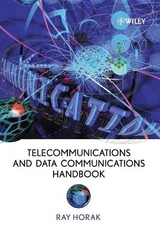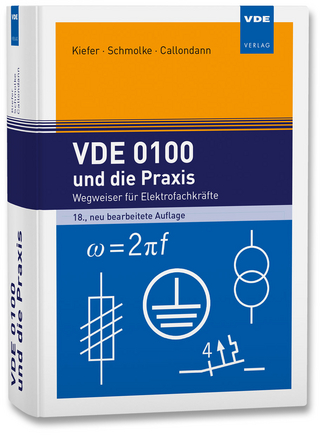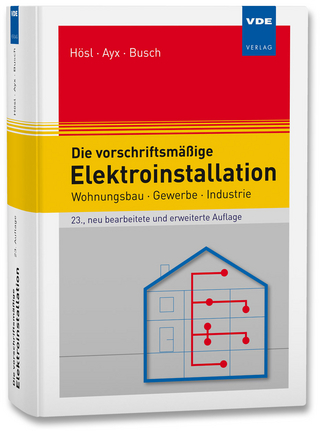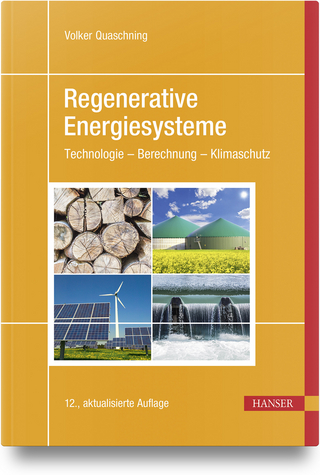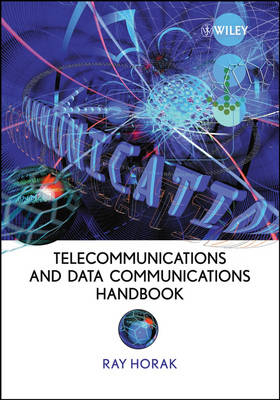
Telecommunications and Data Communications Handbook
John Wiley & Sons Inc (Verlag)
978-0-470-04141-3 (ISBN)
- Titel erscheint in neuer Auflage
- Artikel merken
If you really need to understand telecommunications, you must own a copy of "Telecommunications and Data Communications Handbook" by Ray Horak. A well-researched and comprehensive survey of telecom and datacom technologies and services, from the most basic to the most complex, the book begins with basic concepts and definitions and marches through the full ranges of transmission media and voice, data, and video systems, networks, standards and protocols. The author sets the technologies in context, providing a good level of detail on the origin and evolution of fiber optics, cellular radio, digital carrier systems, TCP/IP, and the Internet, as examples. The emphasis is just right, with plenty of ink devoted to broadband LAN, MAN, and WAN technologies such as 3G, 802.11g/n, ADSL, BPL, CWDM and DWDM, PON, and WiMAX.The author devotes the final chapter to tracking the origins, evolution, and current status of U.S. telecom regulation through key legislative, judicial and agency events.
Back matter includes a helpful list of more than 1,000 industry acronyms and initialisms and an excellent and thoroughly complete index, which is the mark of an author with an appreciation for the reader. Ray Horak writes in a unique plain-English, commonsense style that makes the book an easy read for a technology book. Also, he liberally sprinkles his trademarked (or, more correctly, copyrighted) wry sense of humor throughout, so you will find yourself smiling and chuckling from time to time.While "Telecommunications and Data Communications Handbook" is written for a reasonably astute academic and professional readership of engineers, analysts, regulators, attorneys, and other telecom professionals, Horak develops each topic in plain English and in such a commonsense and patient manner that the book is equally informative and useful to a student or relative newcomer to telecommunications.Among the many of specific technology topics are included the following: 'T/E/J-Carrier Systems' Fiber Optics; MMF and SMF; CWDM and DWDM; EDFAs and Raman Amplification; Passive Optical Network (PON); SONET/SDH Wireless; 802.11a/b/g/n Multiple Input Multiple Output (MIMO); 802.1
6 and WiMAX; Bluetooth; ZigBee; Cellular, including 2.5G and 3G; Broadband over Power Line (BPL); E-mail and Instant Messaging (IM); Storage Area Networks (SANs); Digital Subscriber Line (DSL): ADSL, HDSL, SHDSL, SDSL, and VDSL; CATV Networks and Modems; Voice over Internet Protocol (VoIP), including IP PBX and IP Centrex; and, Session Initiation Protocol (SIP) vs. H.323.Published by Wiley-Inter science (September 2007) 791 pages, $99.95 ISBN-10: 0470041412 ISBN-13: 978-0470041413 The perfect companion to this book is "Webster's New World Telecom Dictionary", also written by Ray Horak in 2007. It is a comprehensive telecommunications dictionary of more than 4,600 terms critical to understanding voice, data, video, and multimedia communications system and network technologies, applications, and regulation. An instant classic that contains none of the fluff found in competing works, "Webster's New World Telecom Dictionary" is a carefully researched and absolutely reliable source. As such, it is the one and only telecom dictionary you will need.
Ray Horak held management and executive management positions with Southwestern Bell, Continental Telephone Company (CONTEL), and Communications Group Inc. An independent consultant and popular speaker, trainer, author, columnist, and writer, he is the author of the bestselling Communications Systems and Networks, published most recently by Wiley and now in its third edition. Mr. Horak teaches seminars around the world on a variety of telecommunications subjects. He also has considerable experience as a consulting technical expert and expert witness in litigation involving patents, copyrights, trademarks, and other intellectual property matters.
Preface.Acknowledgments.About the Author.1 FUNDAMENTALS OF THE TECHNOLOGY: CONCEPTS AND DEFINITIONS.1.1 Fundamental Defi nitions.1.2 Dedicated, Switched, and Virtual Circuits.1.3 Two-Wire versus Four-Wire Circuits.1.4 Bandwidth.1.5 Analog versus Digital.1.6 Loading Coils, Amplifi ers, and Repeaters.1.7 Conversion Process: Modems and Codecs.1.8 Multiplexers (Muxes).1.9 Switches and Switching: The Basics ... and Then Some.1.10 Signaling and Control.References.2 FUNDAMENTALS OF TRANSMISSION SYSTEMS: TECHNOLOGIES AND APPLICATIONS.2.1 Electromagnetic Spectrum.2.2 Transmission Media Selection Criteria.2.3 Twisted Pair: Introduction to Telephone Wire.2.4 Shielded Copper.2.5 Coaxial Cable.2.6 Microwave Radio.2.7 Satellite Radio.2.8 Free Space Optics.2.9 Fiber Optics.2.10 Powerline Carrier.2.11 Hybrid Transmission Systems.References.3 VOICE COMMUNICATIONS SYSTEMS: KTS, PBX, CENTREX, AND ACD.3.1 Key Telephone Systems.3.2 Private Branch Exchanges.3.3 Centrex.3.4 Automatic Call Distributors.3.5 Computer Telephony.3.6 IP Systems.3.7 Futures.References.4 MESSAGING SYSTEMS.4.1 Facsimile (Fax) Systems.4.2 Voice Processing Systems.4.3 Electronic Mail (E-Mail).4.4 Instant Messaging.4.5 Mobile Messaging: SMS and MMS.4.6 Unifi ed Messaging and Unifi ed Communications.References.5 PUBLIC SWITCHED TELEPHONE NETWORK.5.1 Network Characteristics.5.2 Numbering Plan Administration.5.3 Domains.5.4 Signaling and Control: Expanded View.5.5 Network Services.5.6 Portability: A Special Issue.5.7 Equal Access: Another Special Issue.5.8 VoIP: Next-Generation PSTN.References.6 FUNDAMENTALS OF DATA COMMUNICATIONS.6.1 Functional Domains.6.2 DCE: Expanded View.6.3 Protocol Basics.6.4 Network Architectures.6.5 Security.References.7 CONVENTIONAL DIGITAL AND DATA NETWORKS.7.1 Dataphone Digital Service.7.2 Switched 56.7.3 Virtual Private Networks: In the Classic Sense.7.4 Digital Carrier Systems and Networks.7.5 X.25 and Packet Switching.7.6 Integrated Services Digital Network.References.8 LOCAL AREA NETWORKS: CONNECTIVITY AND INTERNETWORKING.8.1 LANs Defi ned.8.2 LAN Dimensions.8.3 LAN Equipment.8.4 LAN Operating Systems.8.5 Virtual LANs.8.6 Remote LAN Access.8.7 LAN Standards and Standards Bodies.8.8 Life in the Fast LAN: The Need for Speed.8.9 Wireless LANs.8.10 Minding Your Ps and Qs.8.11 IEEE 1394 and FireWire.8.12 Nonstandard LANs.8.13 Broadband over Power Line.8.14 Storage Area Networks.References.9 BROADBAND NETWORK INFRASTRUCTURE.9.1 Access Technologies.9.2 SONET/SDH.9.3 IEEE 802.17, Resilient Packet Ring.References.10 BROADBAND NETWORK SERVICES.10.1 Frame Relay.10.2 Switched Multimegabit Data Service.10.3 Asynchronous Transfer Mode.10.4 Metropolitan Ethernet.10.5 Broadband ISDN.10.6 Advanced Intelligent Networks (AINs).References.11 WIRELESS NETWORKING: EMPHASIS ON MOBILITY.11.1 Wireless Defi ned.11.2 Standards and Regulations.11.3 Advantages and Disadvantages of Wireless.11.4 Cell Concept: Frequency Reuse.11.5 Multiplexing and Access Techniques.11.6 Specialized Mobile Radio.11.7 Paging.11.8 Cordless Telephony and Wireless Offi ce Telecommunications Systems.11.9 Cellular Radio.11.10 Packet Data Radio Networks.11.11 Satellite Systems: LEOs, MEOs, and GEOs.11.12 And That's Not All.References.12 VIDEO AND MULTIMEDIA NETWORKING.12.1 Video Communications: Defi ned and Evolved.12.2 Video Basics.12.3 Analog TV Standards.12.4 Digital TV and High-Defi nition TV.12.5 Bandwidth and Compression.12.6 Video Standards.12.7 Internet Protocol TeleVision (IPTV).12.8 The H.320 Family of Multimedia Standards.12.9 Session Initiation Protocol.12.10 H.248: Media Gateway Control.12.11 Videoconferencing Systems.12.12 Videoconferencing Equipment.12.13 WAN Videoconferencing Networks.12.14 Video over IP.12.15 Multimedia Conferencing.Applications and Benefits.References.13 THE INTERNET AND WORLD WIDE WEB.13.1 The Internet Defined.13.2 Internet Physical Topology.13.3 Internet Access.13.4 Internet Standards, Administration, and Regulation.13.5 IP Addressing.13.6 Domain Name System.13.7 Internet Protocols.13.8 Internet Applications.13.8.9 Internet Telephony.13.10 Internet2.13.11 World Wide Web.13.12 Intranets and Extranets.13.13 Internet Security: A Special Issue.13.14 Misuse and Content.13.15 Internet Oddities, Screwball Applications, and Some Really Good Ideas.13.16 The Dark Side: An Editorial.References.14 NETWORK CONVERGENCE.14.1 Convergence Defined.14.2 Driving Forces.14.3 Conventional Convergence: Wireline Networks.14.4 The Race Is On: Mergers and Acquisitions (M&As).14.5 One Potato, Two Potato, Three Potatoe, Four ...14.6 NexGen Convergence: Wireline and Wireless Networks.References.15 REGULATION: ISSUES AND (SOME) ANSWERS.15.1 Telecommunications Act of 1996.15.2 Rates and Tariffs.15.3 The Internet.15.4 Number Portability.15.5 Laws and Sausages.References.APPENDIX A ACRONYMS, ABBREVIATIONS, CONTRACTIONS, INITIALISMS, AND SYMBOLS.APPENDIX B STANDARDS ORGANIZATIONS AND SPECIAL INTEREST GROUPS (SIGs).INDEX.
| Erscheint lt. Verlag | 9.10.2007 |
|---|---|
| Verlagsort | New York |
| Sprache | englisch |
| Maße | 176 x 255 mm |
| Gewicht | 1354 g |
| Einbandart | Paperback |
| Themenwelt | Technik ► Elektrotechnik / Energietechnik |
| Technik ► Nachrichtentechnik | |
| ISBN-10 | 0-470-04141-2 / 0470041412 |
| ISBN-13 | 978-0-470-04141-3 / 9780470041413 |
| Zustand | Neuware |
| Informationen gemäß Produktsicherheitsverordnung (GPSR) | |
| Haben Sie eine Frage zum Produkt? |
aus dem Bereich
